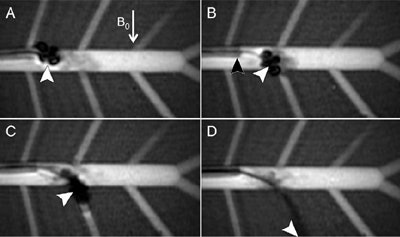
A new steerable MRI-guided catheter can navigate through blood vessels from the groin to the brain in a search for clots to destroy, according to research from the University of California, San Francisco (UCSF).
Faster and more agile than previous MRI-guided catheters, the investigational tool approaches or even surpasses speeds achieved under x-ray guidance in a phantom, and it is now being used in animals, according to its creators.
"This technology allows us to steer under MRI guidance and offers the potential to ultimately treat stroke and other diseases under MRI guidance," said Dr. Steven Hetts in an interview with AuntMinnie.com. It's faster than previous devices "because we use magnetic fields to move the tip of the catheter," he said.
Hetts is an associate professor of radiology at UCSF and chief of neuroradiology at San Francisco General Hospital. He presented the results in late July at the Society of NeuroInterventional Surgery (SNIS) meeting in Colorado Springs, CO.
Big potential
The notion of guidance under MRI for stroke treatment is intriguing, not only for the navigation component, which this study demonstrated successfully, but because MRI is so much more useful than x-ray when brain tissue is involved.
 Dr. Steven Hetts from UCSF.
Dr. Steven Hetts from UCSF."When we're treating someone who has ischemic stroke, we don't know whether their brain tissue is alive or dead at that time of intervention," Hetts said. "We usually have a CT perfusion study or MRI that was done before the patient gets on our angio table, then we try to remove the blood clot from the vessels in the brain. But we don't have any way of knowing in real-time if the tissue beyond the point of the occlusion is alive or dead. And the gold standard way of knowing that is actually diffusion-weighted MRI."
If procedures such as retrieving or dissolving clots can be performed under MRI rather than x-ray guidance, it might be possible to decide in real-time whether the blood vessel should be opened up because the tissue is still viable, or whether it should be left alone because the tissue past the point of occlusion is already dead.
"If the tissue is dead and I open it up, it's more likely to hemorrhage, and the patient is more likely to have a devastating outcome," Hetts said.
Having information about tissue viability would lead to better decision-making and the optimization of patient safety and outcomes, he added.
The MARC catheter
The catheter prototype used in the study, called a magnetically assisted remote-controlled (MARC) catheter, was built using a 1,500-mm-long, 0.97-mm-diameter custom microcatheter. It was based on a commercially available catheter (PX Slim, Penumbra) but made with nonmetallic fibers. The MARC catheter has a solenoid coil at the distal tip, and it is controlled with a foot-pedal actuator that delivers a current of 300 mA.
"There are microcoils embedded on the tip of catheter, and by running a small electrical current that creates a strong magnetic field on the tip of the catheter that interacts with the strong magnetic field of the scanner, we can steer by remote control," Hetts explained.
In the study, the researchers tested three methods of catheter guidance into branch vessels in a cyrogel abdominal aortic phantom:
- The magnetically guided MARC device under MRI guidance
- A conventional catheter guided manually under MRI guidance
- Guidance under conventional fluoroscopy
MRI guidance was provided using a 1.5-tesla scanner (Entera, Philips Healthcare) with a balanced steady-state free precession sequence. The study team collected data on mean procedure times and the percentage of attempts that were successful for each modality.
"You want to get your catheter from our femoral artery access site through the aorta, through the carotid arteries, up into the middle cerebral artery into the brain, so there are a lot of twists and turns between the femoral artery and the brain," Hetts said. "Once you get your catheter there, you usually put the tool through to do an embolectomy or put clot-busting drugs directly into the clot in the brain."
 Above, coronal MR images of the MRI-guided catheter deflecting into a branch vessel arising at 60° from the parent vessel. (A) Catheter tip (white arrowhead) became visible by delivery of current to microcoil and (B) deflected instantaneously while the guide catheter (black arrowhead) remained stationary. (C) The interventionalist then advanced the catheter forward to enter a vascular branch angled 60° to the parent vessel, (D) turning off the current once the tip was within the branch vessel and manually advancing the catheter to the edge of the vascular phantom. Image republished with permission from RSNA from Radiology, June 2014, Vol. 271:3, pp. 862-869.
Above, coronal MR images of the MRI-guided catheter deflecting into a branch vessel arising at 60° from the parent vessel. (A) Catheter tip (white arrowhead) became visible by delivery of current to microcoil and (B) deflected instantaneously while the guide catheter (black arrowhead) remained stationary. (C) The interventionalist then advanced the catheter forward to enter a vascular branch angled 60° to the parent vessel, (D) turning off the current once the tip was within the branch vessel and manually advancing the catheter to the edge of the vascular phantom. Image republished with permission from RSNA from Radiology, June 2014, Vol. 271:3, pp. 862-869.The MARC catheter was easy to visualize under real-time MRI during the tests. Under magnetically assisted guidance, 192 (80%) of 240 turns were completed successfully, compared with 144 (60%) of 240 turns using standard x-ray guidance (p = 0.028).
The MARC device also proved faster than the manually directed catheter under MRI guidance, with a mean procedure time of 37 seconds per turn, compared with 55 seconds for the conventional catheter. Speed was comparable between the conventional catheter with MRI and the manually directed catheter under x-ray guidance, at a mean 44 seconds per turn.
MARC was also faster than the manually directed catheter under MRI guidance for navigating various angles of branch vessels with turns of 45°, 60°, and 75°, the study team reported.
The magnetic nature of the MARC system makes it more adept than conventional catheters for navigating twists and turns, though magnetism isn't used to advance the device to the target, Hetts said.
"We're still pushing with our hand, but the magnetic field [on the tip of the catheter] allows us to steer to a right branch or a left branch, whereas previously that was very hard," Hetts said.
Previous technologies for navigating under MRI are all much slower, he said, rendering them more or less useless in clinical practice.
"No one would want to trade off the time and say, 'Oh, it's going to take me five times as long to navigate under MRI to get to the brain,' " Hetts said. "This is the first study to show we can actually navigate quickly under MRI because we have MARC, which helps us steer efficiently into the brain."
Results of the group's phantom study were also published in Radiology (June 2014, Vol. 271:3, pp. 862-869). But research has proceeded in the months since, with Hetts et al conducting their first successful animal experiments with the technology.
"We've done it in three pigs, not only at 1.5-tesla strength but at 3 tesla, and demonstrated that it can be done successfully," Hetts said. The technology is at least two years away from clinical reality and will need to be evaluated rigorously in humans for U.S. Food and Drug Administration (FDA) clearance. But Hetts is excited about the possibilities.
"This is the first study showing that you can navigate under MRI guidance anywhere close to as fast as under x-ray guidance," he said.



















